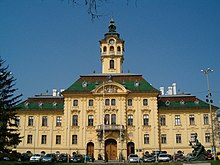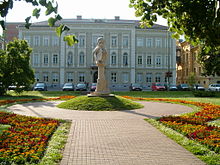| Revision as of 13:39, 19 January 2008 editSquash Racket (talk | contribs)Pending changes reviewers14,116 edits Vandalism rv. to the version compliant with WP:NCGN.← Previous edit | Revision as of 14:46, 19 January 2008 edit undoTankred (talk | contribs)7,836 edits a more sensible list of alternative namesNext edit → | ||
| Line 28: | Line 28: | ||
| }} | }} | ||
| '''Szeged''' ({{audio-IPA|hu-Szeged.ogg|}}), (approximate pronunciation Seg-ed), ({{lang-hr|Segedin}}, {{lang-sr|Сегедин, Segedin}}, {{lang-de|Szegedin/Segedin}}, {{lang-ro|Seghedin}}, {{lang-la|Partiscum}}) is the fourth largest ] of ], the ] of South-Eastern Hungary and the ] of the ] of ]. | '''Szeged''' ({{audio-IPA|hu-Szeged.ogg|}}), (approximate pronunciation Seg-ed), ({{lang-hr|Segedin}}, {{lang-sr|Сегедин, Segedin}}, {{lang-de|Szegedin/Segedin}}, {{lang-bg|Сегет}}, {{lang-ro|Seghedin}}, {{lang-sk|Segedín}}, {{lang-tr|Segedin}}, {{lang-la|Partiscum}}) is the fourth largest ] of ], the ] of South-Eastern Hungary and the ] of the ] of ]. | ||
| == Geographic location == | == Geographic location == | ||
Revision as of 14:46, 19 January 2008
Place in Csongrád, Hungary| Szeged | |
|---|---|
| Votive ChurchVotive Church | |
| Country | |
| County | Csongrád |
| Government | |
| • Mayor | Dr. László Botka |
| Area | |
| • Total | 280.84 km (108.43 sq mi) |
| Population | |
| • Total | 162,889 |
| • Density | 581/km (1,500/sq mi) |
| Time zone | UTC+1 (CET) |
| • Summer (DST) | UTC+2 (CEST) |
| Area code | 62 |
| Website | http://www.szegedvaros.hu/ |
Szeged (), (approximate pronunciation Seg-ed), (Template:Lang-hr, Template:Lang-sr, Template:Lang-de, Template:Lang-bg, Template:Lang-ro, Template:Lang-sk, Template:Lang-tr, Template:Lang-la) is the fourth largest city of Hungary, the regional centre of South-Eastern Hungary and the capital of the county of Csongrád.
Geographic location

Szeged is situated near the southern border of Hungary, just to the south of the mouth of the Maros River, on both banks of the Tisza River (Theiss, Tiscia). Due to the high number of sunshine hours annually, Szeged is often called City of Sunshine (a name she shares with another Hungarian city, Debrecen.)
Demographics
As of 2003, there are 175,301 people residing in the city; 93.5% Magyars, 0.7% Roma, 0.5% Germans (Danube Swabians), 0.2% Serbs, 0.2% Romanians, 0.1% Croats, 0.1% Slovaks and 5.9% other. The population density is 582.9/km². There are 70,787 housing units at an average density of 252.05/km².
History





Szeged and its area have been inhabited since ancient times. Ptolemy mentions the oldest known name of the city: Partiscum. It is possible that Attila, king of the Huns had his seat somewhere in this area. The name Szeged was first mentioned in 1183, in a document of King Béla III.
During the Mongol invasion the town was destroyed and its inhabitants fled to the nearby swamps, but they soon returned and rebuilt their town. In the 14th century, during the reign of Louis the Great, Szeged became the most important town of Southern Hungary, and – as the Turkish armies got closer to Hungary – the strategic importance of Szeged grew. King Sigismund of Luxembourg had a wall built around the town. Szeged was raised to free royal town status in 1498.
Szeged was first pillaged by the Turkish army on 28 September 1526, but was occupied only in 1543, and became an administrative centre of the Ottomans (see Ottoman Hungary). The town was freed from Turkish rule on 23 October 1686, and regained the free royal town status in 1715. In 1719 Szeged got its coat of arms (still used today) from Charles III. During the next years Szeged grew and prospered. Piarist monks arrived to Szeged in 1719 and opened a new grammar school in 1721. They also held scientific lectures and theatrical plays. However, these years brought not only prosperity and enlightenment; between 1728 and 1744 witch trials were frequent in the town. In 1720, the population of the city totalled 193 households, of which 99 were Serbian.
Szeged is known as the home of Paprika. Paprika arrived in Hungary in the second half of the 16th Century as an ornamental plant. About 100 years later the plant was cultivated as a herb, and paprika as we know it was born. Szeged is famous for Szekelygulyas, a goulash made with pork, sauerkraut and sour cream.
The citizens of Szeged played an important part in the revolution and war of independence of 1848-49. Lajos Kossuth delivered his famous speech here. Szeged was the last seat of the revolutionary government in July 1849. The Hapsburg rulers punished the leaders of the town, but later Szeged began to prosper again, the railway reached it in 1854, and the town got its free royal town status back in 1860. Mark Pick's shop – the predecessor of today's world famous Pick Salami Factory – was opened in 1869.
Today the inner city of Szeged has beautiful buildings and wide avenues. This is mainly due to the great flood of 1879, which literally wiped away the whole town (only 265 of the 5723 houses remained and 165 people died). Emperor Franz Joseph visited the town and promised that "Szeged will be more beautiful than it used to be". He kept his promise. During the next years a new, modern city emerged from the ruins, with palaces and wide streets.
After the first World War Hungary lost its southern territories to Romania and Serbia, thus Szeged became a city close to the border, and its importance lessened, but as it took over roles that formerly belonged to the now lost cities, it slowly recovered. The University of Kolozsvár (now Cluj-Napoca, Romania) moved to Szeged in 1921 (see University of Szeged). In 1923 Szeged took over the role of episcopal seat from Temesvár (now Timişoara, Romania).
Szeged suffered a lot during the World War II, 6,000 inhabitants of the city were killed, the Jewish citizens were confined to ghettos, then taken to death camps, and the Soviet army occupied the city in 1944. During the Communist era Szeged became a centre of light industry and food industry. In 1965 oil was found near the city; the area now satisfies 67% of the country's oil demand.
In 1962 Szeged became the county seat of Csongrád. Whole new districts were built, and lots of nearby villages (e.g. Tápé, Szőreg, Kiskundorozsma, Szentmihálytelek, Gyálarét) were annexed to the city in 1973 (as was a tendency during the Communist era).
Today's Szeged is an important university town and a popular tourist attraction.
The famous Open Air Plays of Szeged (first held in 1931) are one of the main attractions; they are held every summer.
Education

The city of Szeged has 62 kindergartens, 32 elementary schools, 18 high schools and a university, which has been established by the unification of the past existing higher education centres. The two most prominent high schools (Ságvári Endre Gyakorló Gimnázium and Radnóti Miklós Gimnázium) are among the fifteen best in the country. Szeged is the higher education centre of southern Hungary and has built quite a reputation for itself. Thousands of students study here, many of whom are foreign students from all around the world. The Centre for Biological Research of the Hungarian Academy of Sciences, which was built with the help of UNESCO funds, has also been a considerable source of advanced research. Scientists at this laboratory were first in the world to produce artificial heredity material in the year 2000. The building has served as a home to many well known conferences and continues to make contributions to the world of science. The University of Szeged was ranked as the best university of the country on Academic Ranking of World Universities - 2005, and one of the best 100 of Europe.
Economy
Szeged is one of the centres of the food industry in Hungary, especially known for its paprika, Szekelygulyas, and Pick salami. Since this country joined the EU in 2004 and will be adapting the Euro currency in 2012, the prices of virtually everything have gone up.
Gallery
- Church of Grey Friars Church of Grey Friars
- File:Szeged17.jpg
-
 Béla IV of Hungary ranked Szeged to city.
Béla IV of Hungary ranked Szeged to city.
- File:Szeged33.jpg
-
 Szeged bridge on Tisza.
Szeged bridge on Tisza.
- File:Szeged 3.jpg
-
 Votive Church at night.
Votive Church at night.
- File:Szeged44.jpg
-
 Aerial photography.
Aerial photography.
- File:Szeged 2.jpg
- Synagogue Synagogue
-
 From the Dome
From the Dome
Main sights
- City centre, Dóm tér ("Cathedral Square") with the Votive Church
- Episcopal palace (centre of the Diocese of Szeged-Csanád)
- Franciscan Church (Gothic, 15th century)
- Serbian Orthodox Church (1773-1778)
- Synagogue http://zsinagoga.szeged.hu/
- Minorite Church (Baroque, 18th century)
- Ferenc Móra Museum
- National Theatre of Szeged
- Botanical Garden of the University
- Szeged Zoo
- Fekete Haz "Black House", Museum of Currency
- Eclectic building of Radnóti Miklós High School (Radnóti Miklós Gimnázium)
Famous people born in Szeged

- Adrián Annus (1975), hammer thrower
- Gábor Agárdy (1922–2006), actor
- Béla Balázs (1884–1949), writer, poet, film critic
- Zsolt Becsey (1964), politician
- Ivan Fellegi (1935), Chief Statistician of Canada
- Rajmund Fodor (1976), water polo player
- Jenő Huszka (1875–1960), composer
- Éva Janikovszky (1926–2003), writer
- Gyula Juhász (1883 - 1937), poet
- Géza Maróczy (1870–1951), chess grand master
- Tamas Molnar (1975), water polo player
- László Paskai (1927), Archbishop of Esztergom
- Willy Pogany (1882-1955), illustrator
- Vilmos Zsigmond (1930), cinematographer
Twin towns
Szeged is twinned with:
References
See also
External links
- Pictures of Szeged By Jim at SnapGalaxy
- Szeged back and now... Template:Hu icon
- Official site with webcam Template:Hu icon Template:En icon
- Another site Template:En icon
- Szeged.hu Template:Hu icon
- Szegedinfo.de Template:De icon Template:Hu icon
- Official site of the Open Air Festival
- szote.com – Website for the non-Hungarian medical students in Szeged
- Template:Wikitravel
- Aerial photography: Szeged
| Counties (vármegyék) of Hungary | ||
|---|---|---|